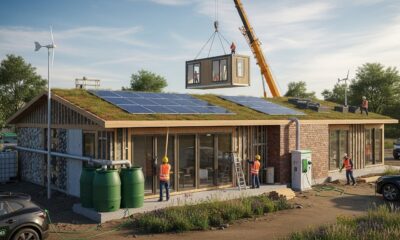

Environment
What Are the Benefits and Features of Eco-Friendly Buildings?
In the past few years, sustainability has become one of the main concerns in every sphere. The construction industry has not been an exception. The market size for green buildings is projected to be worth over $103 billion by next year.
Most developers have eagerly embraced the growing demand for sustainability to keep up with the latest innovations and standards. Therefore, the vast majority of new buildings have eco-friendly features in one way or another.
So, if you are looking for a home that is more sustainable, it’s better to turn your attention to newly-built developments. You can find new build homes on real estate websites dedicated to new projects.
Apart from the number of eco-friendly developments, such properties are also becoming more affordable. Due to a number of new government-backed schemes that help buyers get a home, people are finding its easier to get a property than ever. Most of these schemes only deal with new-build developments, so purchasing an eco-friendly property is becoming more accessible to people on a tight budget. Help to Buy, for instance, helps first-time buyers afford a newly-built home. If you’re interested in purchasing a property in London, using the Help to Buy program, you can find all available homes here. This is the future of eco-friendly buildings in the United States.
So, what is an eco-friendly building?
An eco-friendly building is designed, built, and operated in a way that reduces or eliminates the negative impact other buildings usually have on the environment, such as producing emissions and waste. Furthermore, eco-friendly buildings can have a positive effect on the environment as well as on the people who accommodate them. For instance, certain measures lead to improved health and productivity as well as help save some money by reducing bills.
What kind of special features do eco-friendly buildings usually have?
- Energy efficiency
One of the most important aspects of an eco-friendly building is its energy-efficient features that are aimed to reduce energy consumption and maximize the efficiency of the energy used. For example, such homes can be equipped with solar electric panels, energy-efficient lighting, and sufficient insulation.
- Renewable energy
Another crucial part of the eco-trend is the issue of renewable and nonrenewable sources of energy. Buildings can use solar or wind power to serve them in whole or in part. Although such measures are less common in residential developments than the rest, renewable energy is bound to get an important place in our day-to-day lives.
- Water efficiency
Eco-friendly buildings often come with water use reduction features, such as water-efficient showers, toilets, taps, and appliances. Another way to control your water consumption involves greywater recycling, i.e. taking the water you’ve used in your sinks, dishwashers, showers, and bath and recycling it for other purposes, such as gardening.
- Effective waste and emissions management
To minimize waste and pollution generation, eco-friendly buildings are equipped with well-thought-out recycling systems and smart waste management technologies, such as smart waste bins, waste level sensors, recycling apps, and pneumatic waste pipes.
- Sustainable building materials
Apart from equipment and technologies, it’s also important to be aware of what materials buildings are made of. Eco-friendly construction materials should be non-toxic, ethical, and sustainable. For instance, recycled steel, bio composites, and structural insulated panels.
- Eco-friendly construction methods
Having covered sustainable materials, let’s not forget about construction techniques that are used to protect local flora and fauna during construction as well as to reduce noise and light pollution. Such methods often involve using reclaimed and recycled materials, locally sourced labor, and renewable energy.
- Well-thought-out design
Some measures don’t involve any special materials or technologies. A well-thought-out design can have a significant impact on the level of sustainability all on its own. When a building is designed to fit perfectly into the surrounding environment, it can have a positive influence on local ecology as well as its residents. In addition, an abundance of natural lighting and good ventilation achieved via a meticulously designed layout can help you cut your bills as well.
- Life cycle design
Developers are now more concerned about their buildings’ full life cycles, taking into consideration not only the construction and operation stages but also the buildings’ future renovation and eventual demolition. They need to ensure that every stage is as environmentally friendly as possible.


 Environment10 months ago
Environment10 months agoAre Polymer Banknotes: an Eco-Friendly Trend or a Groundswell?

 Environment12 months ago
Environment12 months agoEco-Friendly Home Improvements: Top 7 Upgrades for 2025

 Features9 months ago
Features9 months agoEco-Friendly Cryptocurrencies: Sustainable Investment Choices

 Features10 months ago
Features10 months agoEco-Friendly Crypto Traders Must Find the Right Exchange




























